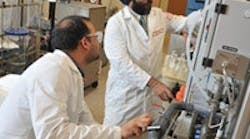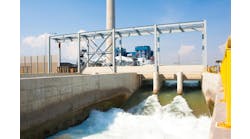ADSORBENT MATERIAL RESEARCHERS
Figure 1. Professor Rominder Suri, right, and researchers developed adsorbents that can more effectively remove emerging contaminants from wastewater than activated carbon. Source: Temple University.
The team synthesized the adsorbents by using different types of cyclodextrins (CDs), compounds containing bound glucose molecules. While CDs normally are soluble in water, the researchers were able to make them insoluble, allowing them to be coated onto support materials.CDs have a greater ability to attract organic compounds than activated carbon, says Rominder Suri, professor of civil and environmental engineering and director of the WET Center in Temple's College of Engineering. "Activated carbon is very porous and water — whether it be surface water, groundwater or wastewater — [and] contains a lot of natural organic matter," he explains. "These are big molecules and when they hit the activated carbon, they block the pores which prevent[s] the contaminant particles from getting inside."The new adsorbent's cavity-like area traps the contaminants. Changing the functional groups on the glucose molecule potentially may enable manipulating the size of the cavity to target and remove select contaminants — something activated carbon can't do, adds Suri. "This new adsorbent material has much less surface area than activated carbon, especially if you coat it on sand. But our results demonstrate that it has comparable, or even better, capacity than the activated carbon. And, it has the potential to be even more efficient by coating it on porous, high surface materials."The team has synthesized a variety of adsorbents using different types of CDs and supports such as silica, filter paper and zeolites, and tested against pollutants such as steroid hormones, bisphenol A, and perfluorochemicals. The materials have removed more than 90% of the contaminants in lab water and discharged wastewater tests, notes Suri. Moreover, the adsorbents boast high thermal stability (up to 200°C), which makes them suitable for handling relatively high temperature streams.Regeneration and reuse of the materials is easy, says Suri. Treatment with a solvent such as methanol or ozone can remove or destroy the trapped contaminants, allowing the adsorbents to be reused. The researchers have put several batches of material through seven successive cycles and it continues to work with the same effectiveness without compromising adsorption capacity, he adds. "These properties could make CD adsorbents a better choice than activated carbon," believes Suri. "Activated carbon is one and done. In industry, once it has been used it will be either landfilled or it can be reactivated through a very energy-intensive and expensive process."Next steps involve further enhancing the adsorbent's efficiency, including coating the CDs onto high-surface-area supports such as zeolites. "We are also looking forward to testing the adsorbents for the removal of other contaminants in different matrices such as tap water, ground water and wastewater effluent," says Suri. Exploring the range and effect of cavity sizes that can be made by tailoring the size for specific contaminants is another area of focus.If all goes as hoped, Suri expects the technology will be ready for pilot-scale testing sometime in 2014. The team already has prepared a batch for a small-scale pilot test.One of the key challenges remaining is the synthesis of CD-based adsorbents in bulk quantities to run pilot-scale experiments. "Since the methods of synthesis of these adsorbents are very simple and do not require sophisticated experimental set up, making them in large quantities should not be a problem," says Suri. "However, this needs to be explored with a commercial chemical manufacturer," he adds.As far as limitations, Suri cautions: "…Because contaminant removal is based on forming inclusion complexes with relatively hydrophobic organic compounds, CDs, like other adsorbents, are ineffective while dealing with highly water-soluble contaminants."

